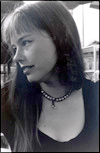
introducing readers to writers since 1995
July 19, 2005
Author2Author: Susann Cokal and René Steinke, pt. 1
by Ron HoganThis spring, I attended events for René Steinke and Susann Cokal, and it had occurred to me early on that getting the two authors together to talk about their flamboyant female protagonists would make for an interesting conversation. Today, René reveals how she decided to center Holy Skirts around Baroness Elsa von Freytag-Loringhoven, a real-life fixture on Manhattan's early 20th-century art scene. You could say that she was a Factory Girl before her time, but I prefer to think of her as the trailblazer without whom the Factory wouldn't quite have come about...at least not the same way. (Tomorrow, we'll undertake a similar exploration of the fictional world of Cokal's Breath and Bones.)
 Susann Cokal: I loved your character of the Baroness--and you obviously love her too. I gather the historical record about the original Baroness is somewhat sketchy, so I'd be interested to know how you connected with her deeply enough to begin your research and your recreation of a life for her. When you first encountered her, what about her sparked your writerly passions? And since she's such a dramatic, larger-than-life character, could you describe the process of shaping her into someone with whom a wide readership can connect emotionally as well?
Susann Cokal: I loved your character of the Baroness--and you obviously love her too. I gather the historical record about the original Baroness is somewhat sketchy, so I'd be interested to know how you connected with her deeply enough to begin your research and your recreation of a life for her. When you first encountered her, what about her sparked your writerly passions? And since she's such a dramatic, larger-than-life character, could you describe the process of shaping her into someone with whom a wide readership can connect emotionally as well?
René Steinke: I was actually attracted to the Baroness partly because of the scant sources--the holes in what's known about the Baroness seemed perfect for fiction, practically invitations to invent. But I began to really feel for her and get a better sense of her character when I read the unfinished autobiography, and the correspondence (there is quite a bit of this) in the papers preserved at the University of Maryland.
I first discovered her when I was writing about William Carlos Williams and wanted to find what his contemporaries said about his book of poems, Kora in Hell. I came across a review in the form of a prose poem (in The Little Review) which attacked his fashion sense, his virility, his American-ness, his marriage, and incidentally, his poems. This was written by the Baroness Elsa von Freytag-Loringhoven. I had never seen anything like this; in that time, it was highly unusual for a female to criticize a male poet so boisterously. I was curious, so I did a little more digging, and discovered her outrageous style of dress, the birdcage necklace, the dress with a flashing taillight, and then I was really hooked. I loved the idea of a truly modern female aesthetic, which she was exploring, and the more I found out, the more excited I became. I couldn't believe no one had ever written about the Baroness before.
She was an outlandish, sometimes self-destructive character, though, and sometimes frustrated and disappointed even her close friends. I'm interested in finding the humanity in characters like her, who many would simply dismiss as "crazy." So I tried to reveal that humanity, her vulnerabilities and desires, as vibrantly as I could. And in the novel, her friends do criticize her--so that gave me a way to show several sides of her.
your PayPal donation
can contribute towards its ongoing publication.